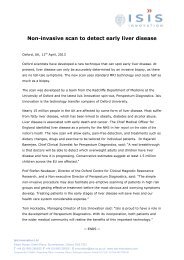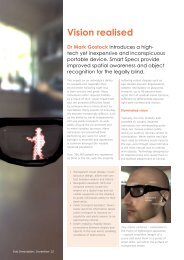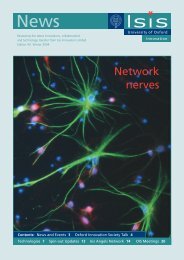Isis insights - Isis Innovation
Isis insights - Isis Innovation
Isis insights - Isis Innovation
Create successful ePaper yourself
Turn your PDF publications into a flip-book with our unique Google optimized e-Paper software.
TargetedTherapyDr Brijesh Roy explains how scientists haveused tissue-specific microRNA (miRNA)expression to create a new class of live viralvaccines which increase immunity whilstpreventing unwanted side effects.MicroRNA and bespoketargetingMiRNAs offer the possibility of saferand more targeted vaccines withgreater efficacy. They can be used toprevent virus replication in the partsof the body where they can causeundesirable symptoms, whilst at thesame time helping the immunesystem to arm itself against thevirus.Although the first miRNAs werecharacterised in the early 1990s, itis only in the last decade that theyhave been recognised as a distinctclass of biologic regulators. MiRNAsare short strings (~22 nucleotides)of highly conserved non-coding RNAthat play a role in normal generegulation. They can inhibit proteinexpression by binding to target siteson messenger RNA and therebyprevent its translation. Ongoingresearch has led to the growingawareness that many miRNAs exhibithighly tissue-specific expressionpatterns. The aberrant expression ofmiRNAs has also been implicated ina number of diseases. Not only havethese discoveries led to thedevelopment of research tools toinvestigate this emerging area ofgene regulation, but this technologyis also being utilised to developdiagnostic and therapeuticapplications.Therapeutic possibilitiesThere are a number of approachesthat can be used for the generationof viral vaccines. Attenuated vaccinesutilise viruses that are still alive, buthave been altered to render themless virulent and effectivelyharmless. These represent the mostimmunogenic and cost-effectivemeans to prevent viral infections.Ideally, a viral vaccine wouldreplicate robustly within the body soas to elicit a complex andlong-lasting immune response, whileat the same time not causing anypathologic effects.A group of Oxford researchers led byProfessor Leonard Seymour, Head ofthe Department of ClinicalPharmacology, have developed astrategy to use miRNAs as a novel<strong>Isis</strong> <strong>Innovation</strong>: Information Invention 24 24
















